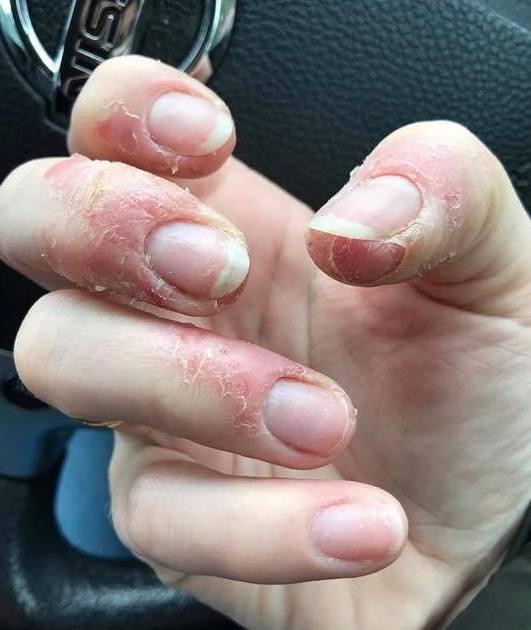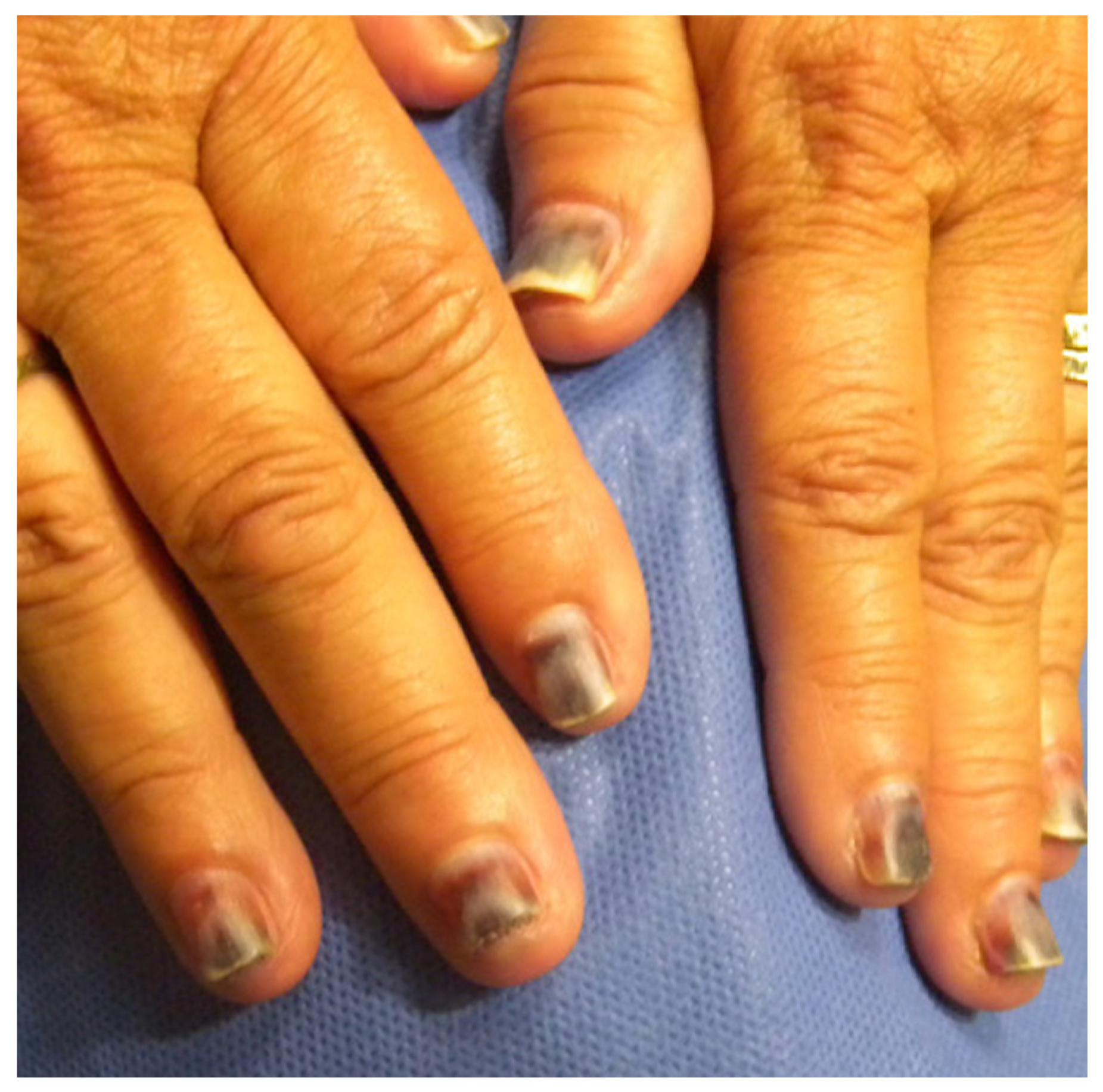Is that seemingly flawless manicure slowly turning into a nightmare of itchiness and discomfort? Contact dermatitis, a skin reaction triggered by various allergens and irritants, is becoming increasingly prevalent, particularly among those who regularly indulge in nail enhancements.
The pursuit of beauty often comes with a hidden cost. For many, the price is paid in the form of contact dermatitis, a condition that manifests as redness, itching, swelling, and sometimes even blistering around the nails. While the allure of perfectly sculpted acrylics or a vibrant gel manicure is undeniable, the chemicals used in these products pose a significant risk. This risk isn't limited to those who get these services; nail technicians, constantly exposed to these substances, are also highly susceptible.
The genesis of this unwelcome reaction can often be traced to the chemicals in acrylic nail products. These chemicals, often including methacrylates, are designed to bond the artificial nails to the natural nail plate. However, these same chemicals can trigger allergic reactions in susceptible individuals. Think of it as a battle waged on the skin's surface, where the body's immune system perceives these substances as a threat, leading to inflammation and the characteristic symptoms of contact dermatitis.
- Jameliz Smith Leak Latest News Exclusive Content
- Aagmaalgives Is It Safe Analyzing Adult Content Trust
Beyond acrylics, other culprits can also be found in the world of nail aesthetics. Nail polish, with its complex concoction of chemicals, fragrances, and other additives, can be a trigger. Even the seemingly innocuous creams and lotions we apply to our hands can contribute to the problem. These substances, through direct contact, can disrupt the skin's natural barrier, leading to irritation and sensitization. The result is a cascade of events that culminates in the telltale signs of contact dermatitis.
The discomfort associated with contact dermatitis extends beyond mere aesthetics. The itchy, inflamed skin can be intensely uncomfortable, disrupting daily life and making even simple tasks a challenge. The rash can be accompanied by blisters, peeling skin, and, in severe cases, even nail separation. The nails themselves can become distorted, with pitting, lifting, or white discoloration, further adding to the distress.
One of the primary culprits behind allergic contact dermatitis in the context of nail enhancements is the family of (meth)acrylates. These chemicals are essential components in acrylic and gel nail products, responsible for their hardening and bonding properties. However, these same acrylates are potent sensitizers, meaning they can trigger allergic reactions in susceptible individuals upon repeated exposure. The more frequently the skin comes into contact with these chemicals, the higher the risk of developing sensitization and, subsequently, an allergic reaction.
- Jackerman Mothers Warmth Chapter 3 Release Insights More
- Vegamovies 4k Your Ultimate Streaming Destination Watch Now
The problem isn't limited to just nail products. In some cases, prolonged or intimate contact with other products can also be the trigger. Sanitary pads, for example, can contain a variety of potential allergens, and prolonged exposure to these products can predispose individuals to allergic contact dermatitis. This highlights the widespread nature of the problem and the importance of being vigilant about the substances we come into contact with.
The diagnosis and management of contact dermatitis require a multi-faceted approach. The first step is often identifying and avoiding the offending substance. This can be achieved through careful observation of the symptoms and, in some cases, through patch testing. Patch testing involves applying small amounts of suspected allergens to the skin to see if a reaction occurs. Once the trigger is identified, the primary treatment strategy is to avoid it completely.
The symptoms of contact dermatitis are quite diverse, and it is essential to be able to recognize them promptly. It frequently manifests with itching around the nails, often being the first sign. This itchiness may develop into dryness, redness, swelling, and the appearance of tiny blisters. The skin may peel or split, and in more serious situations, the nails themselves may start to separate from the nail bed. The visual symptoms can sometimes be quite distressing, and its critical to be aware of these signs to begin treatment early.
Beyond avoidance, various treatments can help alleviate the symptoms of contact dermatitis. Topical corticosteroids are frequently prescribed to reduce inflammation and itching. These medications work by suppressing the immune system's response, thereby reducing the inflammatory response. In more severe cases, oral corticosteroids or other immunosuppressant medications may be necessary. Additionally, emollients and moisturizers can help soothe and hydrate the skin, promoting healing and reducing discomfort.
Preventive measures are crucial in managing contact dermatitis. Georgie Smedley, managing director of The Georgie Smedley Group, often shares valuable tips for preventing contact allergies. These include choosing nail products that are labeled as "hypoallergenic" or "free from" certain known allergens, such as formaldehyde, toluene, and dibutyl phthalate (DBP). Its also helpful to wear gloves when applying or removing nail enhancements. Proper ventilation in salons is critical to minimize exposure to airborne chemicals. Frequent handwashing, using gentle cleansers, and applying moisturizers can also help to protect the skin's natural barrier.
Nail technicians, given their frequent exposure to these chemicals, face a heightened risk. This occupational hazard highlights the importance of preventative measures such as wearing gloves, using proper ventilation, and being meticulous about product application. They can also advocate for safer products, as well as inform clients of potential risks. A proactive approach that prioritizes skin health is crucial for their long-term well-being and career.
It's vital to recognize that contact dermatitis is not a rare or isolated phenomenon. Studies have shown a growing increase in allergic contact dermatitis linked to acrylates found in nail products, which affects both nail technicians and consumers. This trend emphasizes that its not merely a cosmetic concern. Its a widespread health issue that needs urgent attention.
Understanding the various types of contact dermatitis is also vital. Allergic dermatitis occurs when the skin reacts to an allergen, producing an immune response. Irritant dermatitis, on the other hand, occurs when the skin reacts to an irritating substance. The symptoms and treatments can differ, so getting the right diagnosis is important.
Conditions like nail eczema and nail psoriasis can also present with similar symptoms. Both may cause pitting in the nails. However, nail psoriasis can result in nail lifting and white discoloration. Nail eczema can occur at any age, but nail psoriasis typically appears in older adults. Proper diagnosis by a healthcare professional is crucial to rule out these conditions and ensure suitable treatment.
The health of our nails and the skin around them is an important aspect of overall well-being. By being aware of the risks associated with nail products, taking proactive steps to minimize exposure, and consulting with healthcare professionals when symptoms arise, we can safeguard our skin and our general health. The beauty of well-maintained nails shouldnt come at the expense of our health; informed choices are essential.
| Aspect | Details |
|---|---|
| Condition | Contact Dermatitis (Allergic and Irritant) |
| Common Causes |
|
| Symptoms |
|
| Affected Groups |
|
| Prevention |
|
| Treatment |
|
| Related Conditions |
|
This table above encapsulates a comprehensive overview of contact dermatitis as related to nail products and related conditions.
- Explore Masa49 Entertainment Community How To Get Started
- Kelly Piquet Daniil Kvyat The Motorsport Romance Explained


